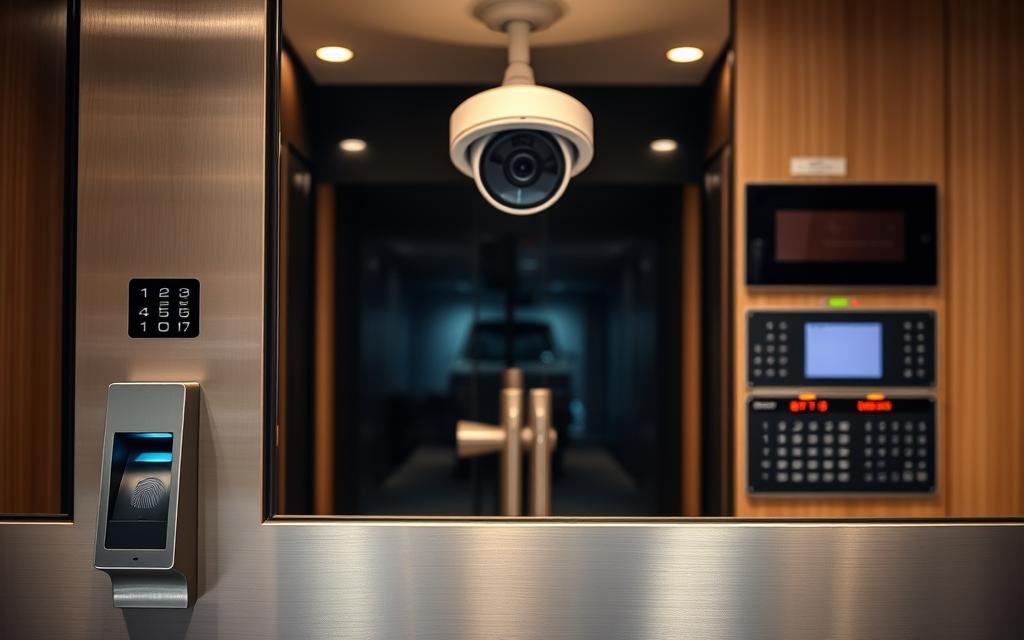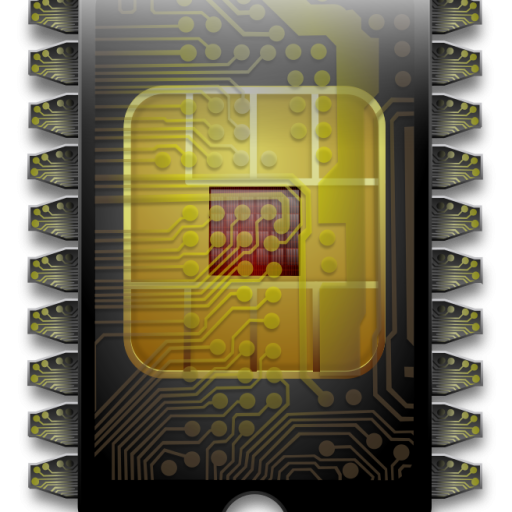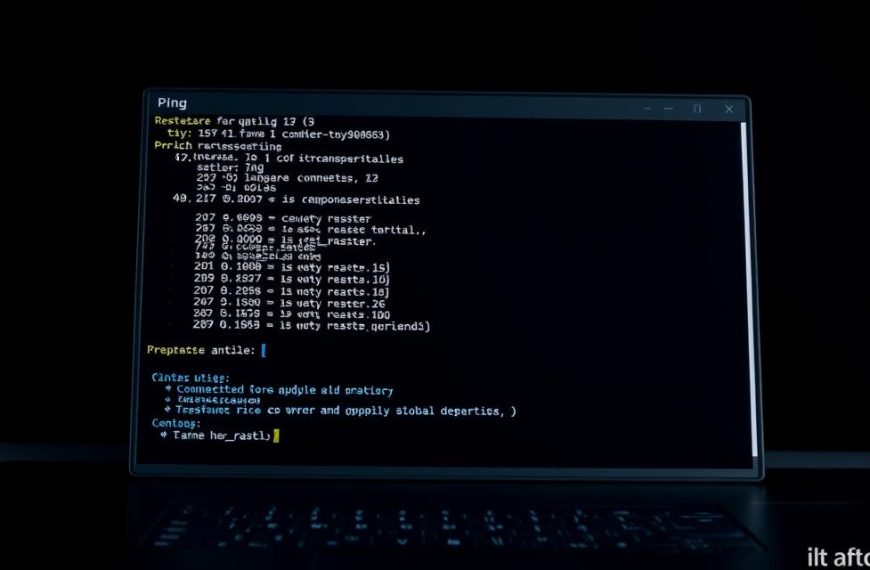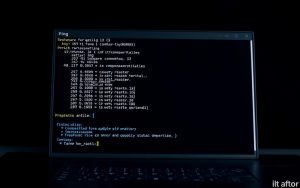Access control is a security process that manages who can view or use resources in a system. It ensures only authorized users gain entry, protecting sensitive data from breaches. Think of it like a subway turnstile—only those with the right keycard can pass through.
This process is vital for preventing unauthorized access and reducing risks. Studies show that 72% of breaches involve privilege abuse, making access control a cornerstone of cybersecurity. It’s also essential for meeting compliance standards like HIPAA and PCI DSS.
Solutions like FortiNAC provide enterprise-grade network protection, aligning with zero-trust architecture. By verifying authentication and enforcing authorization, businesses can safeguard their systems and avoid costly breaches, which averaged $4.45 million in 2023.
Understanding Access Control in Computer Networks
Managing who can enter a system is critical for safeguarding sensitive information. This process involves verifying identities and setting permissions to ensure only authorized individuals gain entry. It’s a cornerstone of modern cybersecurity, protecting data from breaches and misuse.
Definition and Core Purpose
At its core, this framework combines authentication and authorization. Authentication verifies user identities, while authorization defines what they can access. For example, in a hospital, doctors and administrators have different levels of access to electronic health records (EHR). This ensures sensitive patient data remains secure.
Implementations vary widely. Physical methods include keycard scanners and biometric systems, while logical controls involve VPNs and password policies. Both types work together to create a layered defense strategy, minimizing risks.
How It Fits into Network Security
This framework is a key component of broader security strategies. Tools like Microsoft Active Directory simplify management, while multi-factor authentication (MFA) adds an extra layer of protection. The Target breach in 2013 highlights the importance of strict enforcement—attackers exploited weak vendor access controls to steal millions of credit card details.
Government and military environments often use the Mandatory Access Control (MAC) model, which enforces strict policies. Similarly, Security-Enhanced Linux (SELinux) implements MAC to restrict user privileges. These examples demonstrate how tailored approaches can address specific needs.
Key Components of Access Control Systems
Effective security relies on verifying identities and managing permissions. These processes ensure only authorized individuals can use resources, protecting sensitive data from breaches. Three core elements form the foundation of these systems: authentication, authorization, and audit processes.

Authentication: Verifying User Identity
Authentication confirms the identity of users before granting entry. Common methods include passwords, biometrics, and security tokens. For example, Okta’s identity cloud architecture simplifies enterprise-level verification, ensuring only legitimate users gain access.
NIST 800-63B guidelines outline best practices for digital identity verification. These include knowledge factors (passwords), possession factors (tokens), and inherence factors (biometrics). Combining these methods strengthens security and reduces risks.
Authorization: Granting Access Rights
Authorization defines what users can do once authenticated. Two-factor authentication (2FA) in banking and role-based access control (RBAC) in corporate environments are common examples. These systems enforce policies to limit access based on user roles.
OAuth 2.0 uses JWT tokens to manage authorization flows securely. Separation of Duties (SOD) in financial systems ensures no single user has excessive privileges, reducing the risk of fraud.
Audit and Management Processes
Audit processes track user activities to enforce the least privilege principle. Tools like Splunk analyze audit logs, identifying potential security gaps. AWS IAM policy simulator helps organizations test and refine their management strategies.
PCI DSS Requirement 7 emphasizes the importance of least privilege in protecting sensitive data. Regular reviews and updates ensure systems remain secure against evolving threats.
Types of Access Control Models
Different frameworks govern how permissions are assigned and enforced. These models ensure policies align with organizational needs, balancing security and usability. Below, we explore four primary approaches: Role-Based, Mandatory, Discretionary, and Attribute-Based.
Role-Based Access Control (RBAC)
Role-Based Access Control assigns permissions based on job functions. For example, Azure RBAC allows admins to define roles like “Reader” or “Contributor,” ensuring users only access necessary resources. This model simplifies management and reduces risks by adhering to the principle of least privilege.
The NIST RBAC standard (INCITS 359-2012) provides guidelines for implementing this framework. Misconfigured IAM roles, as seen in the Capital One breach, highlight the importance of proper setup and regular reviews.
Mandatory Access Control (MAC)
Mandatory Access Control uses a central authority to enforce strict policies. Security labels classify data, and users are granted access rights based on these classifications. The NSA’s SELinux implementation is a prime example, restricting user privileges to minimize vulnerabilities.
Kubernetes Pod Security Policies also employ MAC, ensuring containers operate within defined boundaries. This model is ideal for high-security environments like government or military systems.
Discretionary Access Control (DAC)
Discretionary Access Control allows resource owners to set permissions. HIPAA-compliant patient portals often use DAC, enabling doctors to share records with specific colleagues. Firebase Realtime Database rules are another example, letting developers define who can read or write data.
While flexible, DAC requires careful management to prevent unauthorized sharing. Regular audits ensure compliance with organizational policies.
Attribute-Based Access Control (ABAC)
Attribute-Based Access Control evaluates multiple attributes dynamically. For instance, manufacturing systems might grant access based on time, location, or user role. This model offers granular control, adapting to complex scenarios.
ABAC rules are ideal for environments with evolving needs. By combining user, resource, and environmental attributes, organizations can enforce precise access rights.
Why Access Control Matters in Modern Networks
Securing sensitive information in modern networks requires robust mechanisms. With 81% of hacking-related breaches involving stolen credentials, the need for effective safeguards is undeniable. Properly implemented systems can reduce breach impact by 70%, making them essential for any organization.
Preventing Unauthorized Access
Unauthorized entry remains a significant threat. The Colonial Pipeline ransomware attack exploited weak VPN credentials, causing widespread disruption. This incident underscores the importance of enforcing strict security measures, such as the principle of least privilege in cloud environments.
Verizon’s 2023 DBIR highlights that credential theft is a leading cause of breaches. Tools like the MITRE D3FEND matrix provide countermeasures to strengthen defenses. By adopting these strategies, organizations can minimize vulnerabilities and protect critical assets.
Mitigating Data Breach Risks
Data breaches can have devastating consequences. The Equifax breach, caused by an unpatched system, exposed millions of sensitive records. Such incidents emphasize the need for proactive measures, including regular updates and compliance with GDPR Article 25’s data protection by design requirements.
Network segmentation and microsegmentation are effective strategies for reducing risks. CrowdStrike’s 2024 threat report reveals that attackers often exploit weak entry points. By implementing layered defenses, businesses can safeguard their networks and maintain trust.
Physical vs. Logical Access Control
Protecting sensitive resources requires both physical and logical safeguards. These two approaches work together to create a layered defense strategy, ensuring only authorized individuals can interact with critical systems. While physical measures focus on tangible barriers, logical controls rely on digital protocols to secure data and networks.

Examples of Physical Controls
Physical access control involves tangible devices that restrict entry to secure areas. Keycard readers, like those from HID Global, are widely used in corporate environments. Biometric scanners, such as those in TSA PreCheck, add an extra layer of security by verifying unique traits like fingerprints or facial features.
Mantraps, which require dual authentication, are another effective solution. Tesla’s Gigafactory uses advanced physical measures, including badge readers and biometric systems, to protect its facilities. These methods ensure only authorized personnel can enter restricted zones.
Logical Controls
Logical access control relies on digital protocols to secure systems. Passwords and multi-factor authentication are common examples. VPNs, such as those using RADIUS protocols, encrypt data transmissions, safeguarding sensitive information during transfer.
Encryption standards like AES-256 and FIPS 140-2 ensure data remains secure at rest. Hardware tokens, such as Yubikey, provide an additional layer of protection compared to software-based solutions like Google Authenticator. SSL/TLS handshakes further enhance secure connections, making logical controls indispensable in modern security strategies.
Implementing Access Control: Best Practices
Implementing robust security measures ensures only authorized individuals can interact with critical systems. By following proven strategies, organizations can reduce risks and maintain compliance with industry standards. Below, we explore three essential practices: the Principle of Least Privilege, Multi-Factor Authentication, and Regular Policy Reviews.

Principle of Least Privilege (PoLP)
The principle of least privilege minimizes risks by granting users only the permissions they need. According to CISA, this approach reduces the attack surface by 86%. For example, the SolarWinds breach highlighted the dangers of excessive privileges, as attackers exploited poorly managed accounts.
Tools like AWS Organizations SCPs help enforce PoLP in cloud environments. By adhering to CIS Critical Security Control 5, organizations can ensure proper account management and reduce vulnerabilities.
Multi-Factor Authentication (MFA)
Multi-factor authentication adds an extra layer of security by requiring multiple verification methods. Microsoft reports that MFA blocks 99.9% of account compromise attacks. Okta’s benchmarks show that combining factors like biometrics and security tokens significantly enhances protection.
PCI DSS Requirement 8.3 mandates MFA for remote access, ensuring compliance across industries. Passwordless authentication, such as FIDO2, offers a modern alternative to traditional workflows, improving both security and user experience.
Regular Policy Reviews
Regularly reviewing access policies ensures they remain effective against evolving threats. NIST 800-207 emphasizes the importance of continuous monitoring in zero-trust architectures. For instance, Microsoft’s Zero Trust Deployment Guide provides actionable steps for maintaining robust management practices.
By conducting periodic audits, organizations can identify gaps and update their strategies. This proactive approach not only enhances security but also ensures ongoing compliance with regulatory requirements.
Challenges in Access Control Management
Managing permissions across modern IT landscapes presents unique challenges. Organizations must navigate complex environments while ensuring robust security and regulatory adherence. Below, we explore three critical areas: dynamic IT environments, balancing security and usability, and compliance complexities.

Dynamic IT Environments
Hybrid and multi-cloud setups create hurdles for effective management. Gartner reports that 68% of companies struggle with hybrid cloud permissions. Snowflake’s cross-cloud access challenges highlight the need for scalable solutions. Tools like Azure Policy Guest Configuration help enforce consistent rules across diverse systems.
Citrix’s CVE-2023-4966 vulnerability underscores the risks of unmanaged environments. By adopting zero-trust principles, organizations can mitigate these risks and maintain secure operations.
Balancing Security and Usability
Striking the right balance between security and user convenience is crucial. Overly restrictive measures can hinder productivity, while lax policies increase vulnerabilities. Multi-factor authentication (MFA) and role-based access control (RBAC) offer practical solutions.
For example, FedRAMP Moderate compliance requires robust yet user-friendly measures. ISO 27001:2022 Annex A.9 provides guidelines for implementing controls without compromising usability.
Compliance and Reporting Complexities
Meeting regulatory requirements adds another layer of complexity. SOX audits mandate 90-day access reviews, while GDPR and CCPA have distinct reporting standards. Proper documentation, as outlined in SOX 404, ensures transparency and accountability.
Gartner’s 2024 IAM Magic Quadrant highlights emerging tools that simplify compliance. By leveraging these solutions, organizations can streamline reporting and maintain regulatory alignment.
| Challenge | Example | Solution |
|---|---|---|
| Dynamic IT Environments | Snowflake cross-cloud access | Azure Policy Guest Configuration |
| Balancing Security and Usability | FedRAMP Moderate compliance | ISO 27001:2022 Annex A.9 |
| Compliance Complexities | SOX 404 access reviews | Gartner IAM Magic Quadrant tools |
Conclusion
Modern cybersecurity relies on adaptive frameworks to safeguard sensitive data. Role-Based and Attribute-Based access control models provide flexible solutions tailored to organizational needs. Continuous adaptive trust models ensure dynamic responses to evolving threats.
AI-driven automation is transforming security policies, enabling real-time adjustments and reducing human error. The shift toward passwordless authentication in 2024 highlights the industry’s focus on user-friendly yet robust measures.
Proper implementation of these strategies ensures compliance with standards like NIST 800-53 Rev. 5. Organizations must assess their network defenses regularly to stay ahead of emerging risks. Investing in advanced access control systems not only enhances security but also delivers significant cost savings by preventing breaches.











